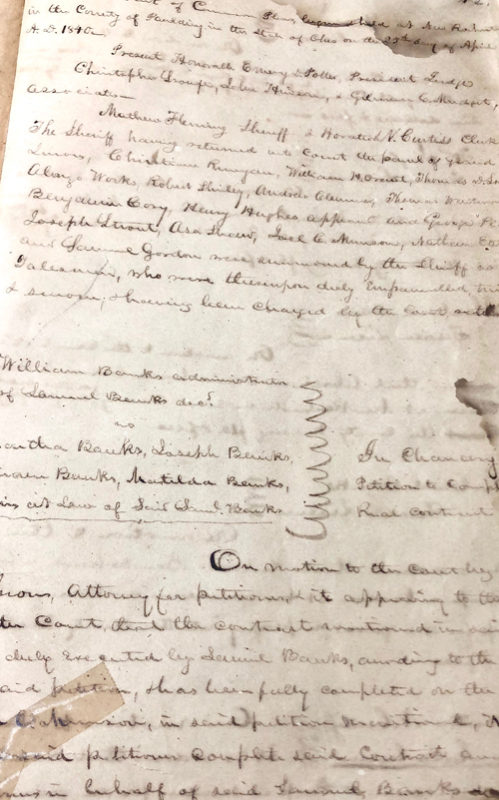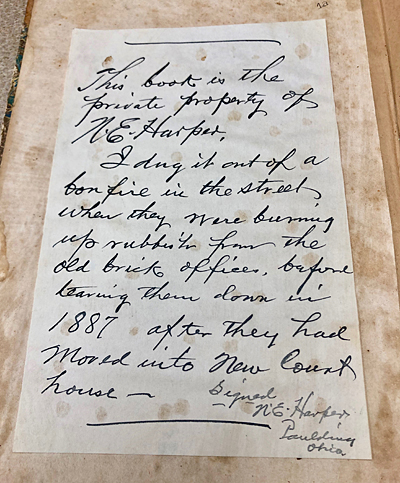Old Paulding County records of interest
Editor’s note: This is one of a series about Paulding County’s Bicentennial celebration, and the second part of a story on historic county records.
JANE NICE/for the Van Wert independent
PAULDING — In a search for the earliest records held in the Paulding County Courthouse, a very old and fragile book was discovered in the Clerk of Courts’ records on a shelf in the basement in a dark and windowless room.

This careworn book is not as thick as many of the other volumes, but it is almost as tall and wide. Its pages are ragged with age and the marks of water damage. Inside the front cover is glued a handwritten note that reads: “This book is the private property of N.E. Harper. I dug it out of a bonfire in the street when they were burning up rubbish from the old brick offices before tearing them down in 1887, after they had moved into new courthouse. Signed N.E. Harper, Paulding, Ohio.”
Somehow these old chancery records, snatched from a fire by a shopkeeper, made their way back into the courthouse. To think this then 50-year-old volume that had already survived the county seat being moved three times — from New Rochester to Charloe to Paulding — makes one grateful for the records that have survived.
Harper saw the value in this book, which details Paulding’s first court sessions after the county had been incorporated and began conducting its own business in 1839. Associate Judges Nathan Eaton, John Hudson, and Gilman Mudgett presided over the court’s first session held on November 21, 1839, in New Rochester.
In the matter of the estate of the late Samuel Banks — the same case where the earliest records from the Probate Court were found — the judges appointed William Banks and Martin S. Runyan “full power and authority … to administer all and singular the said goods and chattels” of Banks’ estate.
In the next session, held in April 1840, Judge Emery D. Potter granted Reason Spurrier, W. Saylor, and Richard Banks licenses to keep taverns in their Carryall Township homes for a fee of $6 each, and he awarded Abraham Davis and Horatio Curtis tavern licenses at New Rochester for $10 apiece.
The first two bills of indictment handed down in Paulding County charged Moses Hanshaw with assault and John Bowman with selling liquor without a license. In April 1841, Hanshaw pleaded guilty to the charges and was fined $5.05. Bowman also pleaded guilty and was fined $15 plus costs.
Making his way through the swampy terrain to hear these cases was no easy task for the judge. According to an early Toledo newspaper clipping adhered to a page in this volume, Judge Potter of Toledo was elected in 1839 for the 13th Judicial District, which included Paulding and nine other counties in northwestern Ohio. Judge Potter then “purchased a magnificent horse on which he traveled about his district. He was compelled to swim streams and wade through deep mud in the almost trackless wilderness to reach places where it was his duty to hold court. He was occasionally compelled to camp out at night or stop at the rude log cabin of a pioneer in making the arduous journeys over his territory. A saddlebag contained his briefs, library and wardrobe.”
In addition to the rescued early court book, the Clerk of Courts maintains an extensive amount of records. One of the more unusual is a “Record of Strays” volume, which lists descriptions of animals that wandered onto the property of others. Within this book are entries like, “Taken Up! Notice is hereby given, that on the 2nd day of June, 1892, the undersigned took up a stray, being a two-year-old steer, roan color, medium size, horns sawed off.”
Across the hall and still on the courthouse’s first floor, the Auditor’s vault holds “Section 16” records dating to 1848. In The Official Ohio Land Book, Dr. George W. Knepper explains that support for public schooling was provided by the Land Act of 1785, which set aside Section 16 in every township for the “maintenance of public schools within said township.”
Recorded in the “Section 16” volume on the “Brown Township” page on July 20, 1848: Royal Cooper paid $18.89 in taxes and Shadrick R. Hudson paid $37.41 in support of their school.
The next earliest tax records in the Auditor’s office can be found in the “Auditor’s Duplicate 1864” volume. Many familiar Paulding County names — Gordon, Hughes, Simpson, Tate, French, Snook — can be found in this book dating back to the Civil War era. For the year 1864, Auglaize Township had the highest total taxes levied, $18.60, and Jackson Township the least, $11.40.
Back in the courthouse basement are the Board of County Commissioner’s records. The earliest volume found there is “Journal 1862.” Much of the early business recorded in this volume has to do with the building of roads and bridges. In that year, David Naveau petitioned for the “establishment of a county road forty feet in width commencing at the west corner of the lock one mile west of Junction and on the north side of the Wabash & Erie Canal; thence running east along Section 24 down to the Junction and crossing the canal at Griffiths Store to intersect the street running near said store.”
Also that year, plans for building a bridge over the Auglaize River were made. Brown Township had collected more than $1,000 to fund the project and Brown Township had collected around $700, together totaling enough for work to begin. The county commissioners approved that the auditor publish a notice for sealed proposals for bridge construction for 30 days in the Paulding Independent newspaper.

The county commissioners also established rules for traveling on roads and bridges. Rules for crossing the Maumee River bridge near Antwerp included, “That no person shall ride or drive any horse or horses stage coach or other vehicle over this bridge faster than a walk; anyone violating this order shall pay for each offense five dollars, provided that the United States Mails shall not be subject to this penalty.”
Carrying fire over the bridge in anything other than a lantern could incur a fine of $5, driving more than ten head of horses or cattle over the bridge at one time could cost the offender $10, and drawing timber over 45 feet long and 12 inches square at one time might set a settler back $25.
Also in 1862, the board of commissioners determined that the courthouse needed repairs, “by lathing and plastering several offices, making two outside hall doors … The old stairs in the hall to be removed and converted into a room for books, and the chimneys to be overhauled and rebuilt. The boards on the outside of the building that are off or become loose to be repaired.”
In another notation, “The Board of Commissioners finding that F.T. Mellinger, county Sheriff, has taken more than ordinary care of the courthouse yard in preventing animals from pasturing or running in it. Therefore, the board gives him the privilege of cutting and appropriating to his own use the grass now growing on the same.”
Back on the main floor, books stored within the vault in the Treasurer’s office only date to the early 1900s. In 1904, the biggest business taxpayers in the village of Paulding were Paulding National Bank, Farmers Banking Company, Cincinnati Northern Railroad, Central Union Telephone Company, and Paulding Gas, Light, and Fuel Company.
Another early book records taxes collected on roads named Payne Pike, Dunakin, Hook, Reeb, Hubbard, Nindeville, and Musselman.
Maybe more interesting than the records held in the Treasurer’s office is the story behind the door to its vault, which has the word “Cleveland” painted on it twice, spelled two different ways. The story goes that the city name was originally spelled C-L-E-A-V-E-L-A-N-D, but long-time Paulding County Judge Calvin L. Noble worked as a printer in Cleveland earlier in his life. There, he worked for the Cleaveland Advertiser. One day he did not have enough space at the top of page one, so he omitted one of the letters, thus changing the spelling of the city’s name.
Next time: How Paulding County was shaped geographically and jurisdictionally between 1820-1845. More information on the bicentennial can be found on Facebook at www.facebook.com/PauldingCounty200.
POSTED: 03/03/20 at 2:10 am. FILED UNDER: News







